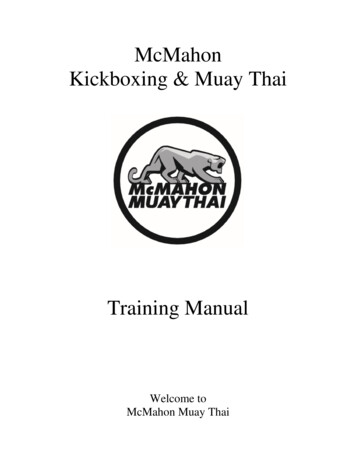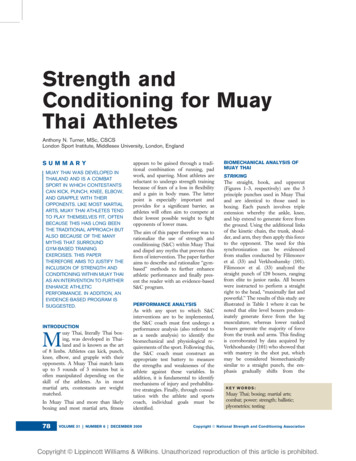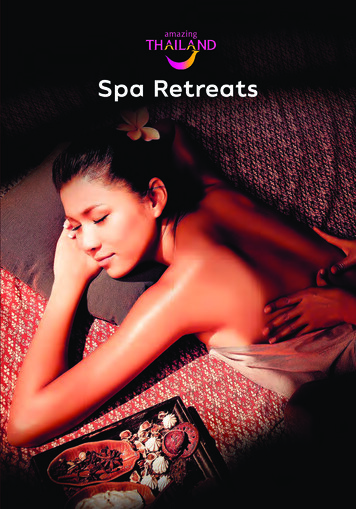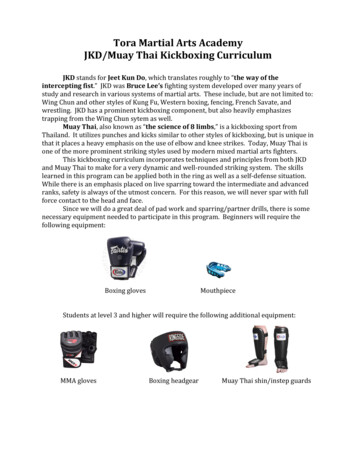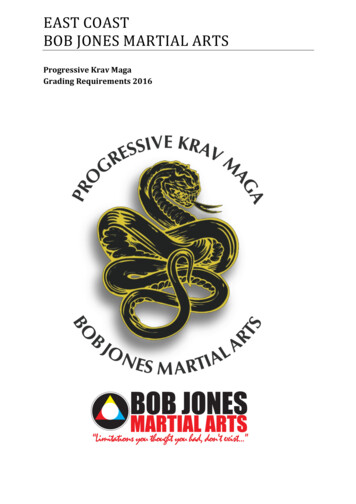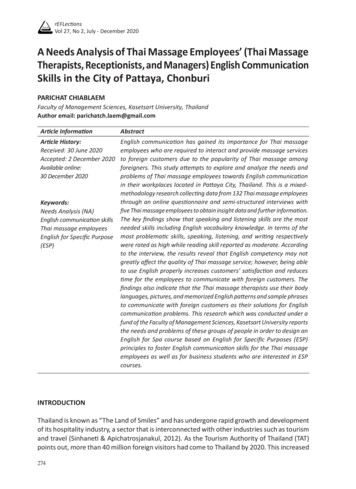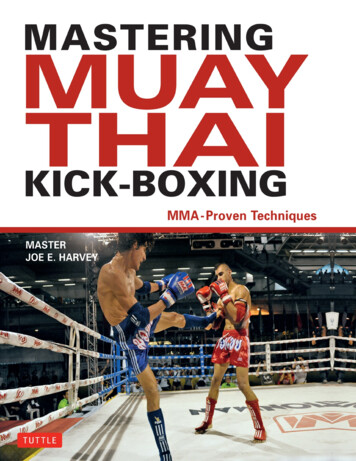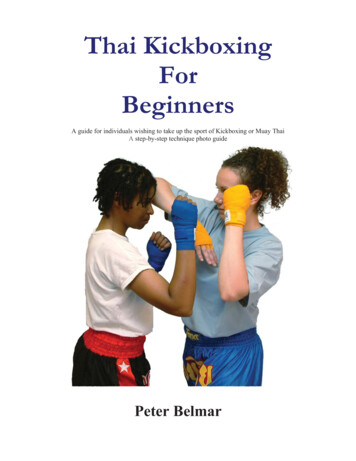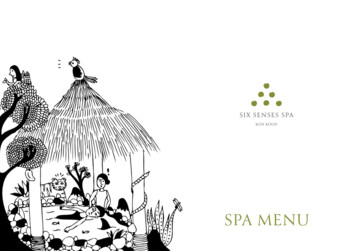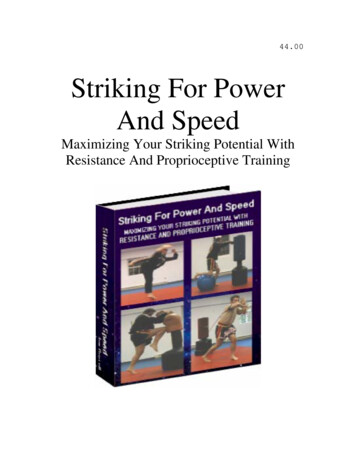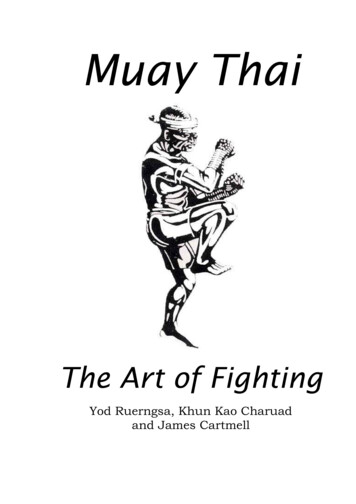
Transcription
Muay ThaiThe Art of FightingYod Ruerngsa, Khun Kao Charuadand James Cartmell
Muay Thai The Art of Fightingby Yod Ruerngsa, Khun Kao Charuad and James CartmellThis DRAFT should not be sold, rented and etc.All reprinting and citation of text in part or whole is prohibited.2
Table of ContentsPreface 6Chapter 1. History and Traditions of Muay ThaiMuay Thai Chronology 7Thai Musical Instruments for Boxing 15Beginner Initiation Ritual .18Pre-fight Ritual .20Wai Kru .23Muay Thai Terminology .37Chapter 1. Cherng Muay (Traditional Basics)Cherng Mad 15 Cherng (15 punches) .44Cherng Sok 24 Cherng (24 elbow strikes) 58Cherng Khao 11 Cherng (11 knee strikes) . .79Cherng Thao 15 Cherng (15 kicks) 89Chapter 2. Kon Muay Thai (Traditional Techniques)Kae Mad 29 Kon .115Kae Thao 23 Kon .133Kae Khao 3 Kon .145Kae Sok 4 Kon .147JuJom 23 Kon 1493
Chapter 3. The Master Tricks and The Complimentary Tricks15 Mae Mai 164Control of Breath .174Stance and Footwork in Detail .177Defensive Head Movements .180Kicking When It Is Too Close To Kick 181Going "Dirty" .183Muay Thai: Throws and Takedowns 185Clinch (Prumb) . 187Chapter 3. Movements of Using Muay Thai Art15 Look Mai 201Basic Combinations 212More Combinations 215Chapter 4. Training Drills, Conditioning and etc.Training Drills 216Improving Punching Power .218Favorite Drills 221Medicine Ball Drills . .222Neck Wrestling Drills 224Thai Pad Drills . .2254
Build Explosiveness . . 228Kicking Speed . . . .238Training to Fight! . .240How not to Flinch, Blink or Turn Away . 243Beginner Muay Thai Training Schedule . 246Conditioning the Shins . .247Common Muay Thai Injuries . .250Dealing with Psychological Problem of "Getting Hit" . .252Basic Technique in Meditation Practice .255Chapter 5. Hand WrappingMuay Thai Hand Wrapping . .256Pro-Boxing Hand Wrapping . .260Hand Wrapping for Heavy Bag Training . 2725
PrefaceWords from Authors.First and Foremost. Techniques described in this book are meant todamage and even kill your opponent, though being properly executedare very damaging and some are potentially lethal. Practice and use themwith caution – it’s your and own responsibility.Second. There are lots of gyms, schools and training camps whereMuay Thai is taught. Cause Muay Thai is living art there are myriads ofvariations of how to call this or that technique, how to execute this orthat strike or training drill. So if you find out that there are somedifferences between what you are taught and what you read in this book– don’t worry. Use your common sense, try both ways, chose what suitsyou more. This book isn’t meant to show the only way, it is meant tohelp to choose YOUR OWN WAY.Third. There are three authors of this book, but in order to makereading easier, all advices are given as from one author.Fourth. Many of you can ask why so few pictures and where are allthese fancy diagrams and stepping patterns? This book lacks them onpurpose. We found out that lots off beginners try to imitate what theysee (in the gym or in the book) without understanding. And it becomeseven worse if someone decides that he can do it after only reading aboutit. We want you, our reader, to benefit from this book. As so – try allyou read in it at your gym, with your partner, ask your trainer about it,discuss it with your friends. In other words – try to fill, try to catch theessence of techniques and drills. Understanding technique is simple,correct execution is much more difficult – but that’s the goal. Andremember PRACTICE IS THE ONLY WAY.6
History and Traditions of Muay ThaiMuay Thai ChronologyMuayThai in the Sukhothai EraThailand’s capital was situated at Sukhothai from around the Buddhist years1781-1951 (1238-1408 CE). Inscriptions in stone columns at Sukhothai indicatethat Sukhothai fought with its neighbors quite often. Consequently, the city had toinstill in her soldiers knowledge and skills concerning the use of weapons such asswords and spears, and also how to use the body as a weapon in situations of closeperson-to-person combat. Skills such as kicking, kneeing, punching, and elbowingwere thus developed.During peacetime, young men in Sukhothai practiced MuayThai to buildcharacter and their self-defense skills. These skills would serve them well duringtheir time in the military and thus the practice of MuayThai became a goodcustom. MuayThai training centers arose around the city, for example, theSamakorn Training Center in Lopburi. Some were in temple areas where monksdoubled as instructors.During this period, MuayThai was considered a higher art and was a part ofthe royal curriculum. It was intended to develop good and brave warriors withgreat physical fitness into great and brave rulers. The first King of Sukhothai,Phokhun Sri In Tharatit, believed in the benefits of MuayThai so much that he senthis two sons to train MuayThai at the Samakorn Training Center to prepare themto take the throne. In B.E. 1818-1860 (1275-1317 CE) Phokhun Ram Khamhaeng7
wrote a war text that included the teachings of MuayThai as well as instruction inother fighting skills.MuayThai in the Krungsri Ayutthaya EraThe Ayutthaya Era lasted from B.E. 1988-2310 (1445-1767 CE). This periodwas characterized by frequent wars between Thailand, Burma, and Cambodia.Therefore, young men had to prepare themselves by developing self-defenseskills. These skills were taught by experienced masters. The training spread fromthe Royal Palace out to the public. The Phudaisawan Sword Training Center wasvery famous in that era, and it had many pupils. They were trained with wickerswords in the arts of sword and pole fighting. They were also trained to fightbarehanded and thus learned MuayThai skills. In addition to fighting, suchtraining centers also gave education in everyday matters.King Naresuan The Great Era (B.E. 2133-2147, 1590-1604 CE)King Naresuan would call for young men of his age to train with him. Theywere trained to be brave, self-confident warriors. They had to be skilful with allweapons and in boxing. King Naresuan set up the Scouting Corps to fight inguerrilla warfare. It was this Corps of soldiers that were able to free Thailand fromBurma during this time.King Narai The Great Era (B.E. 2147-2233, 1604-1690 CE)During this period Thailand was very much at peace and there were manydevelopments in the Kingdom. King Narai supported and promoted sports,especially MuayThai, which became a professional sport. At this time there weremany boxing training centers. The boxing ring was set up in regular playgroundswhere a rope would be laid out in a square shape to indicate the fighting area.Boxers wrapped their hands with threads that were dipped in thick starch or tar.This technique was called Kad-Chuck (wrapped with threads) or Muay Kad-Chuck(boxing with thread-wrapped hands). Boxers wore a head band, called themongkon, and an amulet, or pa-pra-jiat, wrapped around their upper arms whenthey fought. Boxers did not fight according to weight, height, or age. The ruleswere simple: Fights lasted until there was a clear winner. Gambling accompaniedthe bouts. Villages would often challenge each other to boxing matches andboxing became an activity central to folk plays and festivals.King Prachao Sua Era (B.E. 2240-2252, 1697-1709 CE)King Prachao Sua, also known as the Tiger King as well as Khun LuangSorasak, loved MuayThai very much. Once he went, dressed in plain clothes, to adistrict called Tambol Talad-guad with four royal guards. There he entered aboxing competition. The promoter did not recognize the King, but knew that theboxer came from Ayutthaya. He let the King fight against very good fighters from8
the town of Wisetchaichan. They were Nai Klan Madtai (killing fists), Nai YaiMadlek (iron fists), and Nai Lek Madnak (hard fists or punches). The Tiger Kingwon all three fights. King Prachao Sua also trained his two sons, Prince Petch andPrince Porn, in MuayThai, sword fighting, and wrestling.During the early part of the Ayutthaya period the Department of Royal Boxingwas founded. One of its responsibilities was to recruit young talented boxers tofight for the King’s entertainment. The top boxers were chosen for the RoyalQuarries, called Thani Lir (chosen guards). They were responsible for the securityof the royal palace and the King at all times. These boxers were to become theboxing masters who trained the soldiers and the Princes.In the later part of the Ayutthaya Period, after the second loss to Burma in B.E.2310 (1767 CE), there was one boxer of note.Nai KhanomtomNai Khanomtom was a prisoner of war captured by the Burmese whenAyutthaya was sacked for the second time in B.E. 2310 (1767 CE). In B.E. 2317(1774 CE), the Burmese King, King Angwa, wanted to hold a celebration for theGreat Pagoda in Rangoon. Boxing was included in the celebrations. Good Thaiboxers were called on to fight with Burmese boxers. On the 17th of March of thatyear, Nai Khanomtom fought and defeated 10 Burmese boxers in succession withno rest period between fights. It was the first time that MuayThai was used incompetition outside of Thailand. For his achievements, Nai Khanomtom washonored as the Father or MuayThai or the Inventor of MuayThai, and the 17th ofMarch is now named MuayThai Day.MuayThai in the Thonburi PeriodThe Thonburi period extended from B.E. 2310-2324 (1767-1781 CE). It was aperiod of reconstruction after the restoration of peace in the Kingdom. MuayThaitraining was primarily for man-to-man conflict during wars and or militaryservice.The arrangement of competitive boxing bouts during that period involved thematching of different training camps, usually from remote areas of the country.There is no evidence of rules or regulations, and it is thought that boxers foughtwithout any official points system. So, they would fight until one dropped or gaveup, leaving the man standing as the obvious winner.Bouts took place on open grounds, mostly in temple areas. Boxers wrappedtheir hands and wrists in thread, wore a head band or mongkon, and an amulet orpa-pra-jiat usually around their right arm.9
MuayThai in Ratanakosin PeriodThe first era of this period encompasses the rule of King Rama I to King RamaIV (B.E. 2325-2411, 1782-1868 CE). At this time, MuayThai was considered thenational fighting art. It was an essential part of every festival.Eventually, it was decided that rules and regulations were necessary,especially regarding the length of rounds. An intriguing method of timekeepingwas then developed. A coconut shell would have a hole punched in it and befloated in a water tank. When the coconut shell sank, a drum signaled the end ofthe round. There was no limit to the number of rounds, so the boxers fought untilthere was a clear winner or until one of them gave up.King Rama I PeriodPra Puttha Yord Fa Chula Loke, The Great (B.E. 2325-2352, 1782-1809 CE)King Rama I, himself, trained as a boxer from a very early age. He expressedkeen interest in, and often watched, boxing matches. In B.E. 2331 (1788 CE), twoforeigners, brothers who traveled around the world trading goods, arrived inBangkok. The younger of the two proved to be quite a good boxer and won prizesfrom matches around the world quite often. He told Pra Ya Pra Klang that hewanted to fight for prizes against Thai boxers. This request was relayed to KingRama I and, after consulting with Pra Raja Wangboworn, the Director of theBoxing Department, a bet of 50 changs (4,000 Baht) was agreed upon. Pra RajaWangboworn selected a good boxer named Muen Han to fight the foreigner in aring set up behind the Temple of the Emerald Buddha at the Grand Palace. It was20 by 20 meters square and there was a reception area set up nearby. The fightwas not to be scored, but to continue until a decisive winner emerged. Before thefight, Muen Han was oiled with herbal ointment, and he wore amulets on his upperarms. He was then carried to the ring on the shoulders of a friend.When the fight began, it was clear that the foreigner was much heavier, taller,and stronger than Muen Han. When the foreigner got in close he employedwresting tactics to try to break the Thai boxer’s neck and collarbone. To counterthese tactics, Muen Han tried kicking and using stepping kicks. He tried to controlthe fight and his footwork was very quick. Eventually, the foreigner began to tireand it seemed he was going to lose. His brother, realizing this, jumped into thering to help his younger brother. This caused a riot to break out among thespectators. Many foreigners were injured. The two brothers, after recovering fromtheir injuries, left Thailand.10
King Rama II PeriodKing Pra Buddha Lert La Napa-Lai (B.E. 2352-2367, 1809-1824 CE)While young, this King trained as a boxer at Bang Wa Yai Training Center(Wat Rakangkositaram) with the boxing master, and army general, SomdetPrawanarat (Tong You). At age 16, he learned more about MuayThai from theBoxing Department. He changed the sport’s name from its previous name, RamMad Ram Muay, to MuayThai.King Rama III PeriodKing Pra Nangklao (B.E. 2367-2394, 1824-1851 CE)King Rama III learned MuayThai from the Boxing Department. During hisreign, Thai boys loved to fight, and they learned MuayThai and the sword of KhunYing Moe. Khun Ying Moe is renowned for leading many brave women to defeatthe invading soldiers of Prince Anuwong from Vientienne, Laos, who wereattacking the city of Korat.King Rama IV PeriodKing Chomklao (B.E. 2394-2411, 1851-1868 CE)When young, King Rama IV loved to dress himself up as a boxer. He alsoloved sword and pole fighting. Often, he would box and compete in sword andpole fighting during festivals in the grounds of the Temple of the EmeraldBuddha. During this time, Thailand saw the growth of western sports and culture.However, MuayThai remained a popular activity and a strong symbol of Thaiculture.King Rama V PeriodKing Chulachomklao (B.E. 2411-2453, 1868-1910 CE)King Rama V learned MuayThai from the Boxing Department with boxingmaster Luang Pola Yotanuyoke. The King loved MuayThai and loved watchingboxing matches. From time to time he would order Royal officers to arrange forgood boxers to fight for him. Such tournaments were used to recruit men for HisMajesty the King’s Royal Guards.King Rama V recognized the value of MuayThai. In order to promote interestin Thai sports, the King encouraged MuayThai tournaments. He also encouragedthe promotion of Muay Luang, or royal boxing centers to train youngsters. TheseMuay Luang also organized and controlled MuayThai tournaments. The royaloffice would also send official invitations to the heads of Muay Luang inviting11
their boxers to participate in particular events and festivals. Winners at suchevents were promoted by His Majesty the King to a position callen ‘Muen’, orfirst-rank officer.In B.E. 2430 (1887 CE), King Rama V established the Department ofEducation. MuayThai was a subject in the curriculum of the physical educationteacher’s training school and at Prachufachomktao Royal Military Cadet School.This period is considered the golden age of MuayThai.King Rama VI PeriodKing Mongkhut Klao Chao Yu Hua (B.E. 2453-2468, 1910-1925 CE)During this period, Thailand went to World War I. The Thai army wasstationed in France with General Praya Dhepasadin as Commander. He lovedMuayThai and he organized a bout to entertain the European servicemen andlaymen. They enjoyed the bout very much and thus was born European interest inMuayThai.In B.E. 2464 (1921 AD), after the war, the first permanent boxing stadium wasbuilt on the football ground at Suan Khulab School. It was named the SuanKhulab Boxing Stadium. At first, spectators would sit or stand around the ring.The ring itself was a square, 26 meters by 26 meters. Boxers wrapped theirhands with cotton threads, wore a head band or mongkon, and an amulet or pa-prajiat around their upper arms. They wore shorts with a protective cup and theirwaists were belted by a long piece of cloth. They wore neither a shirt nor shoes.The referee would wear an old style Thai dress uniform with a royal white shirtand white socks.One great fight from this period was between Muen Mad Man, aged 50, andNai Pong Prabsabod, a tall man aged 22 who came from Korat. The younger manfought to avenge the death of his father who was killed in a bout with Muen MadMan that took place at the funeral of Khun Marupongsiripat. Two minutes into thegrudge match, Muen Mad Man was knocked out by Nai Pong. The spectatorsbecame very excited and went mad trying to congratulate Nai Pong. It took sometime for the situation to calm down.This kind of scene was clearly a problem and a committee was set up to solveit. Finally, it was decided that the ring should be raised to a height of four feetabove the ground, be covered with grass mats tied together, and surrounded by a 1inch think rope. There was to be a space for each boxer to enter the ring near itscorner. The referee began wearing a full scouting uniform and there was now atime keeper with two watches. A drum was used as the round signal and a matchwas established at 11 rounds of three minutes each. Boxers were to break whenthe referee so ordered, and it was now forbidden to bite one’s opponent or to attack12
him while he is falling. Boxers had to go to a neutral corner when their opponentfell down. Music for the fights was played by the orchestra of Muen SamakSiangprachit.King Rama VII PeriodKing Pok Klaochao Yu Hua (B.E. 2468-2477, 1925-1934 CE)General Dhepasadin built a boxing stadium called Lak Muang at Tachang(near the present day National Theatre). The ring rope was thicker and tighter andwithout a space to protect the boxers. Bouts were organized regularly.In B.E. 2472 (1929 CE) governmental orders required all boxers to wearboxing gloves. Boxing gloves were introduced to Thailand by a Philippine boxerwho came to Thailand for an international boxing match. Prior to the introductionof boxing gloves there was a tragic and fatal accident when Nai Pae Liangprasertfrom Ta Sao, Uttaradit province, killed Nai Jia Kakamen in a boxing match whichwas fought in the Kad-Chuck style where boxers’ hands were wrapped in cottonstrips.In November B.E. 2472 (1929 CE) Chao Khun Katatorabodee first organizeda boxing bout along with other festivities at a fun park in Lumpini Park. He choseonly good boxers to fight every Saturday. An educated and worldly man, he builtan international standard boxing ring with three ropes and a canvas floor. Therewere red and blue corners, two judges, and a referee in the ring. It was here that abell was first used as the round signal.To celebrate on New Year’s Eve of that year, a match was scheduled betweenSamarn Dilokwilas and Det Poopinyae, accompanied by a special bout betweenNai Air Muangdee and Nai Suwan Niwasawat. Nai Air Muangdee was the firstboxer to use a metal protective cup. It has since been in general use.King Rama VIII PeriodKing Ananddhamahidol (B.E. 2477-2489, 1934-1946 CE)Between B.E. 2478-2484 (1935-1941 CE), a rich and well-known man built aboxing stadium on Chao Chate’s ground. It was called Suan Chao Chate BoxingStadium. At present it is the Department of Reserved Officers Training Corps.The stadium was run by military personnel and it did very good business.Some of the income was donated to support military activities. After several years,the Second World War broke out. At that time the boxing stadium was closed.Japanese troops arrived in Thailand on December 8 B.E. 2484 (1941 CE).13
From B.E. 2485-2487 (1942-1944 CE), while the war was still going on,boxing bouts were organized in movie theaters during the daytime. There wereboxing stadiums at Patanakarn, Ta Prachan, and Wongwian Yai where the publiccould be entertained.On the 23rd of December, B.E. 2488 (1945 CE), Ratchadamnern boxingStadium was opened officially. Mr. Pramote Puengsoonthorn was its chairman andPraya Chindharak was its administrator. The promoter was Mr. Chit Ampolsin(Kru Chit). Bouts were organized every Sunday from 4 to 7 p.m. The rules werethose of the Department of Physical Education. Bouts were five three-minuterounds in length, with two minutes rest between rounds. The boxers were weighedby stone. Two years later, weight was measured in kilograms, and in B.E. 2491(1948 CE) pounds were adopted as the measure of a boxer’s weight so as to be inaccord with international standards. Divisions were assigned by weight, forexample, not over 112 pounds. International names were given for each weightgroup, such as flyweight, and bantamweight. Matches were arranged to select achampion for each class, following the international style. Many additions havebeen made to the regulations of Muay Thai. It is forbidden now to hit the privateparts since this technique has become quite infamous as a form of attack and isconsidered debasing for the fine art of Thai boxing.Muay Thai remains a national art form. If all parties concerned help touplift and conserve this form of martial arts, and pass it onto following generations,it will remain a valuable possession of the Thai nation.14
Muay Thai Traditions and RitualsThai Musical Instruments for BoxingMuay Thai is still developing, but what remains unchanged is the use of the pipeand the drums as musical accompaniments for the matches, and is considered aunique characteristic of Muay Thai.For dancing one may use a record player, but for thai boxing it is imperative tohave live music. For the prefight rituals and during the fight itself the tempo ofmusic is increased to encourage the fighters to put forth their best efforts. There arethree Thai musical instruments for boxing.Traditional Thai instruments used during and before the fights are the Pi, the Chingand the Glawng Khaek.The PiThe Pi Chawa or Java Pipe, it is believed, owes its origin to India where theJavanese secured their model. It appears that the instrument was used in both15
Royal and Army processions and in accompanying the traditional Thai fencingbouts. The stirring sound which it makes is somewhat like the Chanta on ScotchBagPipes.The Pi Chawa is made in two sections; a cylindrical body 10 3/4 " in length and abell or horn in 5 1/2 "long.It is made of hardwood or ivory or both. Along the bodyare seven finger holes. Four pieces of reed in double pairs are tied to a small metaltube. The end of the tube is inserted into the body of the instrument and wrappedwith thread to make the connection sung. At rhis end of the tube there is also asmall round convex piece of metal or coconut shell to support the performer’s lips.The ChingThe Ching which is a percussion instrument of the cymbal type comes in pairs andis made of a thick metal shaped like a tea-cup or hollow cone. The Ching is playedby hitting the two pieces together. Each one measures about 6-7 cm, 2 1/2"-2 3/4 :in diameter.At the apex of each there is a small hole through which a cord is passed. A knot ateach end of the cord fits inside the apex of the cymbal and prevents the cord fromslipping through. The cord fastens the two cymbals together and holds them inplaying positions. The function of the Ching is to keep time and to beat out therhythm.The name Ching is onomatopoetic, coming from the sound made when the twoedges of the cymbal are struck together and the sound is allowed to persist. It is amelodious and chiming sound. When the two cymbals are struck together and thenheld together, it is produces a dull clapping sound.16
The Glawng KhaekThe Glawng Khaek has a long cylindrical body which is made of hardwood and is58 cm. (23") in length. The heads are of unequal size, the larger being 20 cm. (8")in diameter called Na rui (literally "loose") and the smaller 18 cm. (7") in diametercalled Na tan ("outer head"). The two heads are made of calfskin or goatskin.Originally the two heads were tied down with cane or rattan which was split in halfand tied apart, but now owing to the difficulty obtaining good rattan and cane,leather tongs are usually used. The drums are used in pairs and are of differentpitches. The higher toned drum is referred to as tua pu (male) and the lower toneddrum as tua mia (female).They are played with the palms and the fingers of the hands and both drumheadsare used. There is one player for each drum. A complex rhythmic line is created bythe inter-mingling and alternating of the sounds of the two drums.17
Beginner Initiation RitualThai boxers are prone to believe in magic spells, and the occult in the believe thatsuch ploys could stop the opponent who would be too puzzled to fight. Fighters areknown to have gone as far as to recite spells in graveyards particularly thosereputed to be haunted, so as to facilitate meditation, strength, courage and increasereadiness to face a man.In general, students of Thai boxing are usually initiated into a camp via aninitiation ceremony. The chosen day is usually Thursday, (Thursday is consideredthe day of the god of arts and skills). The student would bring flowers, incensesticks, candles, towels and a water container to the teachers house. He would alsobring with him 6 twenty-five Satang coins and 6 pieces of white cotton cloth.Depending on the amount of students who are to be initiated, a small feast isprepared, with pork, duck, and chicken with other foods and fruits.The teacher would pick up either a glove or the sacred cotton laurel and raise itabove his head, then the students to be initiated would bow to the teacher threetimes and put out his arm to be held by the teacher while holding the glove orlaurel. Both the teacher and the student should be holding the article while theteacher begins to incite the blessing of knowledge;"Buddhang Prasit Dhammang Prasit Sangkang Prasit, Narayana is ChaoPrasit Pawantute" (Meaning the one who confers knowledge).When the teacher releases the hands of the student, then holds the article abovehis head to pay respect to Rama, where he bows three times, he then faces theteacher and bows three more times towards him. The teacher then makes thefollowing blessing;"Siddhi Kijang, Siddhi Kammang, Siddhi Techo, Chaiyo Nijang, ChaiyaSiddhi Pawantute"If there is pork or duck etc., then the teacher will take a knife and slice a pieceoffering this to the student, while reciting "This object is given by Narayana to allhis pupils so that they could be powerful and enjoy lasting happiness". The studentmakes another sign of respect and eats the piece of meat. There is always a largecontainer of holy water and a statute of Buddha, which is placed in the middle tobear witness to the ceremony. Holy water is sprinkled on the student and theteacher would offer the student the wearing of the holy cotton laurel, which isgoverned with the following spell;Om Sri Siddhi Deja Chana Satru Na, Ma, Pa, Ta You see me. Your mind shouldbe gloomy, worried, without sense Namo Buddhaya makes you captivated,believing that I am Ong Promma Chaiya Siddhi Pawantume".18
One of the spells used by King Naresuan during his march against the Burmese,is often used in this ceremony; "Pra Chao 5 Pra Ong" (Five Gods) NamoBuddhaya;Na Yan Bot Songkram ( Na the region of the war), Ma Tid tam Satru (Mafollow the enemy) Bud Tor Su Pai Rin, (Bud fight the foes) Cha Sin Pol Krai(Dha conquer all forces) Ya Chok Chai Chana (Ya glorious victory).When fighting at close quarters King Naresuan used the following spell inengaging the enemy in battle.Na Dej Rukran (Na, might invades), Ma Tao Harn Fan Fad (Ma, courage instriking), Pa Pikat Home Huek (Pa, destroy without fear), Ta Prab Suek ToiTod (Ta, repel the enemy)."19
Pre-fight RitualWhen fighters enter the ring, they traditionally are seen wearing a Mongkon ontheir heads, and Pong Malai around their necks.MongkonThe Mongkon (or Mangala) is the traditional head band which is always worn byMuay Thai fighters . It is usually made from a special cotton yarn, which has beencarefully bound together in a special way. This item is used to represent the gymthat you are fighting out of. It is essentially a crown. Fighters never own theMongkon themselves, it is gym property. Also, fighters are not to touch theMongkon. It is placed on their heads and removed by their Kru or trainer. It servesto remind the fighter that he is in the ring representing his gym or camp, nothimself. In the past, each gym had a distinct Mongkon, and one could identify whatgym a fighter was from by the Mongkon worn.Pong Malai are the floral wreaths worn around a fighter’s neck when he enters thering. Pong Malai literally translates to "Group of Flowers". It is almost identical inpurpose to a Hawaiian Lei. Pong Malai are given to a fighter by friends and fans asa good luck gesture. Pong Malai are also commonplace in Thai culture outside ofthe boxing ring. Again, much like a Hawaiian Lei.When the fighter steps into the ring, they always go over the top rope. TheyNEVER duck under or between the ropes to enter or exit the ring. This is asymbolic gesture that is closely related to Thai culture. In Thai culture, a person’shead is considered to be the most important part of the body, practically a holyobject. The feet, by contrast, are considered lowly and dirty. A fighter shouldALWAYS enter the ring over the top rope so as not to allow his head to go beneathanything.When the fighter is in the ring, he goes to the center to bow to each of the fourside
The Phudaisawan Sword Training Center was very famous in that era, and it had many pupils. They were trained with wicker swords in the arts of sword and pole fighting. They were also trained to fight barehanded and thus learned MuayThai skills. In addition to fighting, such training
